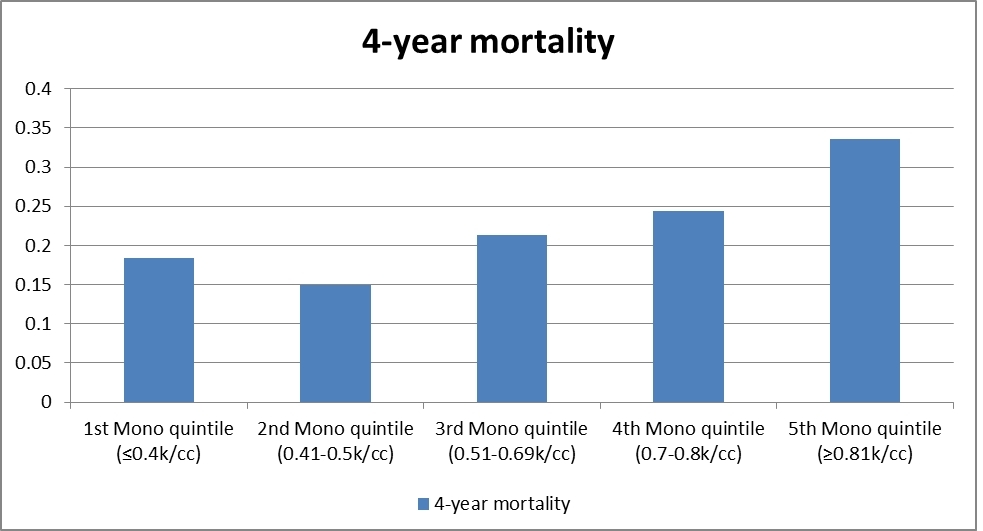|
Back to Annual Meeting Posters
Pretreatment Elevated Peripheral Blood Monocyte Count Is a Negative Predictor of 4-Year Cancer-Related Mortality in Colorectal Cancer Patients
Basem Azab*, Neeraj Shah, Steven Vonfrolio, William Lu, Karen E. Gibbs, Scott W. Bloom
Surgery, Staten Island University Hospital, Staten Island, NY
Background:
Inflammation plays a major role in cancer biology and outcomes. Studies have demonstrated that tumors with increased tumor-infiltrating monocyte counts are associated with tumor angiogenesis and degradation of extracellular matrix, which increases potential of metastasis. Moreover, prior studies demonstrated the association between elevated peripheral blood monocyte and cancer-related survival in various cancer populations (colorectal, ovarian, mesothelioma, melanoma, leukemia and others). The prior studies evaluated the monocyte count in the metastatic colorectal cancer patients had limited studies sizes (<100 cases). The aim of this study is to ascertain the value of using the circulating monocyte count to predict cancer related survival among colorectal cancer patients.
Methods:
Cancer-specific mortality was obtained from our prospectively maintained cancer registry database.1534 patients were diagnosed with CRC between 2005 and December 2009. Patients were included if they had a complete blood count with differential before any modality of treatment (surgery or chemotherapy). Exclusion criteria were: absence of differential blood count before treatment, patients with bowel obstruction on presentation, patients with hematoproliferative disease, evidence of infection at the time of presentation, those treated with steroid or immunosuppressive medications. Two independent physicians reviewed the charts for the demographic, presentation, laboratory, pathological, management and outcome variables. Patients were then divided into five equal quintiles according to their pretreatment monocyte count [1st Mono quintile (Mono ≤0.4k/cc) = 125 patients, 2nd quintile (Mono 0.41-0.5k/cc) = 114 patients, 3rd quintile (Mono 0.51-0.69k/cc) = 108 patients, 4th quintile (Mono 0.7-0.8k/cc) = 127 patients and the 5th Mono quintile (Mono ≥ 0.81k/cc) = 113 patients].
Results:
A total of 587 patients met the inclusion criteria. The 5th monocyte quintile had a significant higher 4-year mortality compared to the 1st and 2nd monocyte quintiles (38/113= 34% vs. 23/125= 18% and 17/114= 15%, p values 0.008 and 0.001 according to Fisher's exact two-tailed test). In multivariate analysis including the cancer stage, monocyte count was independent predictor of survival (Hazard ratio of 1.35, 95% Confidence interval 1.11-1.64, p=0.0003). Figure 1 illustrated the trend of higher mortality along the monocyte quintiles.
Conclusion:
Elevated pretreatment circulating monocyte count was a significant predictor of long-term cancer specific survival among colorectal cancer patients.

Figure 1: The 4-year cancer-related mortality according to the pretreatment peripheral blood monocyte count among colorectal cancer patients .
Back to Annual Meeting Posters
|


